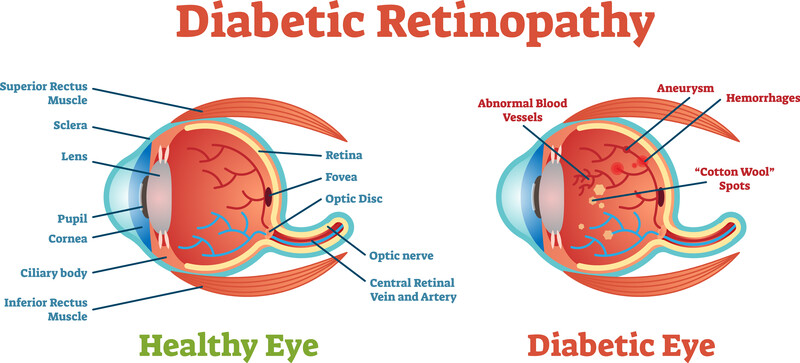Posted by: Eye Specialists of Mid Florida in Blog

By: William Corkins, O.D.
Patients who present with a diabetes history are worried about their vision. If the patient has type II Diabetes, the following is the discussion I have with the patient to simplify the process that occurs in a person with diabetes. When the patient with type II diabetes is in for an eye exam, I ask them what three problems they will have as time goes on. Most patients are not aware, so I tell them. The first is neuropathy, the second is kidney failure, and the third problem is retinopathy. Neuropathy is when you get numbness and tingling in your extremities, which is usually the first sign of diabetes. Next, your kidneys will start to fail, and lastly, you develop bleeding and leakage in the retina that can lead to blindness. I also ask them if they know that they can get rid of their type II diabetes. Most patients are not aware that they can do so.
To simplify and understand the disease process, imagine I have a garden hose attached to a faucet stretched across the lawn to fill a bucket. Then, imagine I take an ice pick and punch holes in the hose, starting from the faucet and working the way across the yard to the end of the hose. If you compare the water flow when the hose has no holes to when I added the holes from the faucet to the end of the hose, you will notice a decrease in the flow. If I make enough holes, the water flow at the end will stop. This is what happens in diabetes.
The hose represents our arteries that carry blood from our heart to our organs. Blood keeps our organs alive. Our arteries are made of muscle, and what happens in diabetes is the muscle wall breaks down, and blood starts to leak out of the wall of the arteries. The more leakage out of the wall, the more the blood flow thru the artery is decreased to the end organ it is feeding. If you decrease the blood flow enough, the tissue will die. That is why with diabetic patients, often you will see their toes and legs being amputated.
In the eye, blood flow to the retina is decreased. The retina is why we see. When the blood flow is decreased enough, the body senses this, and a chemical inside the eye is released. This chemical causes new blood vessels to form. The body thinks that if it grows new blood vessels, this will allow more blood to flow to the retina, keeping it alive. This is a smart defense mechanism, but here is the problem. The new blood vessels that form are extremely brittle. If you shake your head, the newly formed blood vessels can break. When they break, you have massive bleeding inside the eye. Eventually, the bleeding would stop, but the eye was filled with blood. As the blood is being reabsorbed, sticky bands that attach to the retina start to contract, which can cause the retina to detach, leading to blindness.
When we have the above happen, this is called retinopathy, and we can treat it in two ways. First, we use medicines that are injected into the eye. These medicines stop the chemical released into the eye that causes new blood vessels to grow. Before these injections, we would use a laser to treat the retinopathy. Using the laser to treat retinopathy sounds like an advanced treatment option, but in reality, it is a very archaic way of treatment. When we treat the retina with a laser, spots of laser light are placed onto the retina. The amount of spots applied is usually a lot. The laser spot used generates heat. The heated spot burns and destroys the retina. So what the laser is doing is destroying the retina.
What I have observed through the years when someone is being treated for their type II diabetes: The patient finds out their blood sugar is high. The patient looks at the doctor and says what are you going to do? The doctor starts the patient on medication and schedules a follow-up visit. On follow-up, the patient’s blood sugar is still too high. Again, the patient looks at the doctor and says what are you going to do? The doctor changes the medication and schedules a follow-up visit. On follow-up, the blood sugar is still not good. The patient looks at the doctor and says what are you going to do? The doctor adds a new medication and schedules a follow-up visit. What should happen is instead of the patient looking at the doctor and asking, what are you going to do? The doctor then needs to look at the patient and ask, what are you going to do? By losing weight, exercising, and eating correctly, you will see your blood sugar come down. If you are on medication, you will see the amount of medication decrease. If you keep on track, you will see your diabetes diagnosis go away. I typically see that patients will accept the numbness and tingling neuropathy.
They will accept kidney failure and dialysis treatments. They will accept amputation of their toes and legs. But when they start to lose their vision and find out the treatment does not make them see better but only extends what vision they have a little longer, they begin to take the disease seriously. At this point, guess what? It is too late to turn things around. So do not back yourself into this corner. Take control. It will not be easy and requires a lifestyle change.
Now you know how to get rid of your type ll diabetes. As the saying goes, JUST DO IT! If you are a diabetic patient and notice issues with your vision, call us at 800-282-3937 to schedule a diabetic eye exam. Dr. William Corkins is a board-certified optometrist who sees patients at the Haines City location for Eye Specialists of Mid-Florida. He is accepting new patients at this time.

